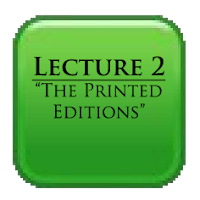This podcast is one part in a series of three lectures given by Dr. Royal Skousen as part of his 25 year magnum opus work on the textual criticism of the Book of Mormon.
About Royal Skousen
Skousen has published three books on this subject: Analogical Modeling
of Language (1989), Analogy and Structure (1992), and Analogical Modeling: An
Exemplar-Based Approach to Language (2002). More recently, he has published on
the quantum computation of Analogical Modeling, notably in his 2005 paper
"Quantum Analogical Modeling" (available here).
Skousen has been the editor of the Book of Mormon Critical Text Project
since 1988. In 2001, he published the first two volumes of the Critical Text
Project, namely, typographical facsimiles for the original and printer's
manuscripts of the Book of Mormon. From 2004 through 2009, he published the six
books that make up volume 4 of the critical text, Analysis of Textual Variants of the Book of Mormon. This work
represents the central task of the Critical Text Project, to restore by
scholarly means the original text of the Book of Mormon, to the extent
possible. In 2009, using the results from volume 4, Skousen published with Yale
University Press the culmination of his critical work on the Book of Mormon
text, namely, The Book of Mormon: The
Earliest Text. The Yale edition presents the reconstructed original text in
a clear-text format, without explanatory intervention. Unlike modern editions
of the Book of Mormon that have added chapter summaries, scriptural
cross-references, dates, and footnotes, this edition consists solely of the
words dictated by Joseph Smith in 1828-29, as far as they can be established
through standard methods of textual criticism. Later emendations by scribes,
editors, and even Joseph Smith himself have been omitted, except for those that
appear to restore original readings. Skousen is currently writing volume 3 of
the critical text, The History of the
Text of the Book of Mormon, which will be available in about three years (~2016).
Skousen has recently accepted the assignment
to be one of the editors for the Joseph Smith Papers, along with Robin Jensen,
charged with the task of preparing the three volumes that will reproduce
photographs and facsimile transcripts for the two manuscripts of the Book of
Mormon.
For those interested, Skousen's vita is available via Brigham Young University here.
For those interested, Skousen's vita is available via Brigham Young University here.
About this Lecture
 |
| The Gordon B. Hinckley Alumni and Visitors Center |
In this lecture, Royal Skousen discusses the history and significance of the dictated original manuscript for the Book of Mormon as well as the printer copy of the book of Mormon.
There are two manuscripts of the Book of Mormon: the original manuscript
(O) and the printer’s manuscript (P). O is the dictated manuscript (the one the
scribes wrote down as Joseph Smith dictated the text). Only 28 percent of O is
extant, of which 25 of the 28 percent is held by the LDS Church. P is a copy of
O made by Oliver Cowdery and other scribes. For five sixths of the text, P was
used as the copytext by the 1830 typesetter, John Gilbert.
During February 1830, Oliver Cowdery took P to Canada in an attempt to
secure the copyright to the Book of Mormon within the British realm. During
that period of time, one sixth of the 1830 edition (from Helaman 13:17 to the
end of Mormon) was set from O.
This lecture will cover all the major discoveries that have been made
about the two manuscripts over the past 25 years. The original manuscript,
despite its incompleteness, is the most important source for determining the
original text of the Book of Mormon as well as providing crucial evidence on
how Joseph Smith translated the book.
This information was taken largely from Interpreter: A Journal of Mormon Scripture.
This information was taken largely from Interpreter: A Journal of Mormon Scripture.





